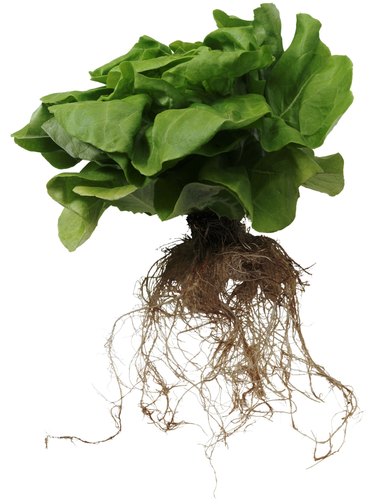
Aeroponics is a variation of hydroponics. In aeroponics systems, plants are grown with their roots suspended in a dark, closed container. There is no gravel or root support substrate as in hydroponics, so the roots are exposed to high oxygen content at all times. Aeroponics systems aren't watered in the usual sense of gardening. Instead, roots are sprayed or misted with nutrient solution and kept at a constant nearly 100 percent humidity. Intervals of spraying nutrient solution vary, depending on the system being used and the crop being raised. Plants achieve optimal root growth, with resultant high water and nutrient uptakes.
History
Video of the Day
NASA brought attention to aeroponics in the 1960s when it began investigating soilless ways of raising food that could be used in the low-gravity conditions that are present in space travel. NASA continues to investigate aeroponics aboard the space station Mir. Since then, a number of commercial aeroponics systems have been developed for research, industrial and home use.
Video of the Day
Nutrient Delivery
Earlier aeroponics systems used spray nozzles directed at the regions of root growth in the chamber. Since then, different delivery systems have been developed. A system developed in Israel pumps water to the top of the chamber and uses centrifugal force to create a spray of fine drops. Another system uses a pump that throws water against a curved plate at the top of the chamber, delivering water back into the root area as fine droplets. Misting jets that deliver 10 liters of nutrient solution per hour are used in an Australian commercial system. The Aero-Gro system, also developed in Australia, uses ultrasonic technology to break water into a mist of very fine droplets, creating a nebulizer system. A homemade version of an aeroponics system uses misters. Some systems incorporate a fluid layer at the bottom of the chamber that the roots can grow into when they are long enough.
Spray Intervals
Douglas Peckenpaugh, in "Hydroponic Solutions: Vol. 1," states that variables such as temperature, the type of aeroponics system used, pump capacity and the size of the root systems affect how often roots should be sprayed or misted. For warm climates, he suggests a spray interval of 15 seconds every three to five minutes, checking to be sure the root systems don't dry out. "The Big Book of Self-Reliant Living, 2nd," advises leaving low-pressure misting nozzles on continuously or timing them to be on for 20 seconds and off for 40 seconds. In actual practice, experimentation needs to be done to determine the best spray interval for the specific system and crop.
Advantages

Plants can be grown year-round in little space, with as many as six crop cycles a year for a crop like tomatoes. Roots develop well because of the high oxygen availability and high relative humidity. According to NASA, water use is reduced 98 percent, fertilizer use 60 percent and pesticide use 100 percent.
Disadvantages
Without soil or a growing substrate, the roots have no buffer against lack of moisture, making it critical to have a spray interval that keeps the roots moist. However, constant spraying defeats the purpose of saving water and encourages the growth of fungi. Walter Szykitka, in "The Big Book of Self-Reliant Living, 2nd," mentions adding a fungicide to the nutrient solution to prevent growth of fungal root pathogens. Spray and mister nozzles can become plugged and need to be checked regularly. Setting up an aeroponics system can be expensive and maintenance can be time-consuming.